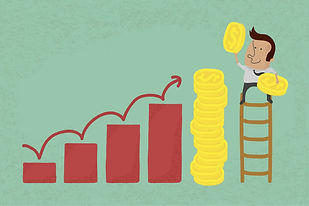
Mr. Dostert's Domain


Economics and the Future
As we have discussed at some length, Economics is the study of choices and decision-making. One of the most difficult and important decisions we have to make is planning for the future. It is often easy to identify our goals for our life, but how we get there is often much more challenging because we can not anticipate all of the things that will happen to us as we plan for the future. There is a clear method that enables us to plan effectively so that we are prepared for the unexpected and we are able to financially plan our future.

Goal-Setting
One important aspect in financial planning is goal setting. Goal-setting is important because it directs the planning based on your current position compared to the desired goal. There are two different types of goals, short-term and long-term. A short-term goal is a goal which takes you in the direction toward your ultimate long-term goals. The time frame is irrelivant for short-term goals because the time it takes to reach a long-term goal can vary greatly depending on the goal. A long-term goal is a goal which is the final result we seek. Although once acquired the goal must be maintained or is sometimes altered, a long term goal is a final step. Following this model, graduating from college is actually a short-term goal because for most of us college is attended in order to get a better paying or more fulfilling job. The career you seek after college is the actual long-term goal.
The Planning-Process

1. Evaluation
2. Set Realistic Goals
Before making any plans you need to evaluate your current situation. Before goals can be set there must be a clear understanding of what resources are available to you and what you would like to see change in your life.
Once you fully understand your current situation you must set well thought out goals. These goals must be realistic and clear so that there is no doubt when the goal has been achieved. These goals should be both long-term, and short-term.
3. Take Action
Do the things necessary to achieve the goals. Create a plan with your goals in mind and implement it. Remember that if the goal is something you desire it will ultimately be worth the hard work that goes into it.
4. Monitor Progress
Regularly reflect on your plan and make alterations if necessary. Keep your goals in mind and determine if the actions you have taken have moved you closer to these goals or not. Do not be afraid to admit a mistake and alter your course. If the action does not move you closer to your goal, reassess your plan and adapt it to the new circumstances.

Financial Planning
Saving, Budgeting, and Investing
When we simplify financial planning to its most rudimentary form it comes in three forms: Saving, Budgeting, and Investing. These three actions are all necessary in order to have a successful economic plan for the future. These things are done not exclusively as money. By attending school you are investing in yourself with the hopes that at some point the knowledge you acquire can be used for something useful in your future life. When you save a photograph it is so that at some later point you can look back at it and enjoy it. By keeping a calandar or day-planner you are budgeting your time. Without a doubt, saving, budgeting, and investment are essential to any plan for the future.


Saving
Saving is the most simple form of financial planning. Saving is simply holding on to resources for use at a later time. To calculate savings we subtract spending from income. The problem with saving is seen with inflation. Because over time the value of money generally decreases, it forces the person saving to save more money for future purchases than the cost currently is. Therefore saving is not the best financial plan for the future.

Budgeting
Budgeting is perhaps the most important aspect for any financial plan. A planned budget calculates income and spending to create a plan that will allow you manage money more efficiently and to not spend more than is taken in. The problem inherent in budgeting money is that there are always unforeseen events that happen throughout anyone's life and therefore extra savings should always be included to prepare for emergencies.

Investment
Investment is a necessity for any financial plan. Investing is buying or creating an asset with the expectation that it will appreciate in value so that when the asset is liquidated its value will be higher than the initial amount, therefore giving the investor a profit. The problem with investment is that investments do not always appreciate and there can be extreme risk to investing.

Balancing Your Financial Plan
It is important to remember whenever you are financial planning that things are never certain, and it is important to diversify investments. You can not rely too heavily on any one aspect of financial planning and should always use saving, budgeting, and investment to have a secure and safe financial plan.

The Stock Market
The most popular form of investment is the stock market. The stock market is a market place which brings together investors who wish to buy or sell stocks (also called shares). The stock market has become the representation of capitalism and allows buyers and sellers to come to terms in real time as the value fluctuates throughout the day.

Stocks & Bonds
A stock or share is a piece of a company that is purchased as an investment by stockholders. As the value of the company rises or falls so too does the value of each share. The total number of shares available in the market is determined at the formation of the business and issued by the company. This number can be increased only if authorized by existing shareholders. It is important to note that stocks represent a fraction of ownership in the company, therefore whomever owns the greatest amount of stock owns a controlling stake in the company.

Bonds are legal forms of debt used by companies or governments to raise funds. Bond issuers sell bonds to the public who in turn hold the bonds until a specified time in which they mature and can be sold back to the company for a profit based on a predetermined rate of interest for the bondholder. Bonds are a much safer investment because there is less risk on the part of the purchaser because the bond must be repaid whether the busines is doing well or poorly at the time of maturity.

Stocks and bonds are both securities. The major difference between the two is that stockholders purchase equity stake in the company whereas bondholders have a creditor stake in the company. This means that bondholders must be repaid prior to stockholders in the event of bankruptcy. Furthermore once bonds reach their defined term and mature, the bond is redeemed and their stake in the company ends whereas stocks can be held indefinately.
Stock Exchanges
A stock exchange is a form of exchange which provides services for stock brokers and traders to buy or sell securities. Stock exchanges usually act as continuous auctions constantly negotiating transaction on the floor of the exchange to allow buyers to compete for the best price.

The New York Stock Exchange
The World's largest stock exchange is known as the New York Stock Exchange (NYSE). Located at 11 Wall Street in Lower Manhattan it has become the central platform for trading stocks in the United States as well as a potent symbol for the American Market Economy. It has been estimated that $170 billion worth of trades are made every day at the exchange. The NYSE opened in 1817 and since its incorporation has been the site of many highs and lows including a bombing in 1920, the 1929 Crash which initiated the Great Depression.

The NASDAQ
The NASDAQ is the second largest stock exchange in the world and is also located in New York. The NASDAQ was founded in 1971 as the world's first electronic stock market. The NASDAQ quickly assumed the majority of OTC trading and was the first stock market in the United States to trade online. The NASDAQ has over time become known as the high-tech market, attracting many firms dealing with the internet and electronics. In turn this market is seen as more volatile and growth oriented.

Other Stock Exchanges
There are a variety of Stock Exchanges around the world which trade stocks. Some of these include the London Stock Exchange in the United Kingdom, the Japan Exchange Group in Tokyo, The Shanghai Stock Exchange, the Euronext of the European Union, and the Deutsche Börse Group in Germany. Each operates much like their American counterparts but using their own currency and products. Together these stock exchanges are often used to site how different economies of the world are opperating and alert economists to potential problems for the future.

Bull Markets and Bear Markets


Economists view the outlook of the stock market in two forms: a bear market or a bull market. A bull market is a period of expansion and growth in the market when stocks are generally rising and optimism is high. During this phase investors are rapidly buying stocks because they feel that their investment is safe and secure. On the contrary a bear market is a period of contraction in the stock market where shareholders begin to sell off their stocks in fear that their value will decline. During a bear market there is a general pessimistic mood in investment preventing buyers from entering the market and buying shares of companies. Generally speaking a bull market lasts much longer than bear markets due to most people's natural optimism for the future. These market trends are unpredictable and brokers constantly watch the ups and downs of the market in hopes of dodging bear markets and buying prior to the charge of a bull market.















Taxes
It is easy to be discouraged when you see the number of taxes taken from our paycheck. It can feel like your money is being taken without your consent after you worked hard for it. However, taxes are an integral part of society and taxes are how societies collectively finance goods and services for the public that are in everyone's best interest.

Tax Structures
When a taxes are levied they are designed in three different models based on what the tax is designed to do. The three principle structures a tax can take is proportional, progressive, and regressive.

Proportional taxes are taxes in which a percentage of income is paid that is the same for all income levels. With a proportional tax, whether income goes up or down, the percentage of income paid in taxes stays the same. Proportional taxes are sometime referred to as a "Flat Tax." Progressive taxes however increae the percentage paid as income increases. The federal income tax is perhaps the best example in the United States. Progressive taxes are created under the premise that those with more wealth can afford to pay more and therefore should bear the burden of higher levels of taxation. Finally, regressive taxes is a tax in which the percentage of income paid in taxes decreases as income increases. For example, a sales tax rate remains constant regardless of the person's income level. Because people with lower incomes will spend a greater percentage of their income on the tax than a wealthy buyer, the tax burden is felt greater by them. It does not mean that they pay more than people with higher incomes, only that the tax consumes a higher percentage of their wealth.



